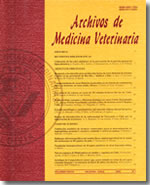Effect of genotype and sex on fiber growth rate of alpacas for their first year of fleece production
Main Article Content
Abstract
The sale of alpaca fiber is the main income for thousands of families in the Central Andes of Peru. Little information exists on the fiber length growth rate of alpaca (FLG), especially throughout their first year of life when the fiber is most valuable. We aimed to determine the monthly FLG of 22 alpaca offspring of two genotypes (9 Suri, 13 Huacaya) and considering sex differences (10 females, 12 males) in the High Andes of Peru. FLG growth was determined using dye-bands. An additive lineal model with three factors (genotype, sex, month) was used for statistic analysis. To evaluate the effect of genotype and sex on the profile of the FLG throughout the year a two factor repeated-measures model was used. The results showed that FLG was affected by genotype and month but not sex. The Suri genotype had 20% higher FLG than Huacaya genotype alpacas (1.34 vs 1.10 cm/month, P < 0.001). FLG increased over each of the first three months (P < 0.05) and then maintained a near constant rate for the remainder of the first year. The resulting staple length indicates that shearing at ages from 8 to 12 months of age will provide fleeces of sufficient length for textile processing.

